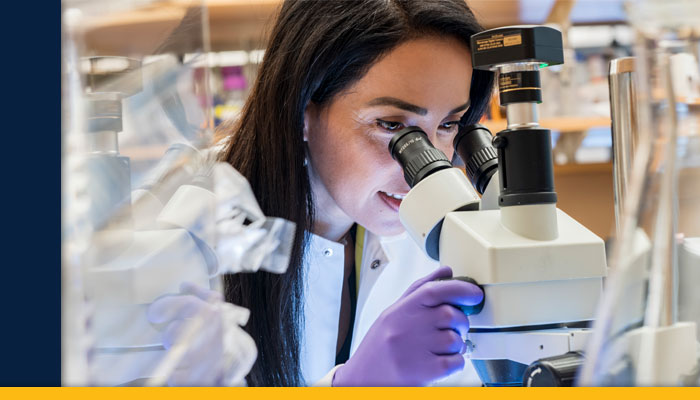
The Hale Building for Transformative Medicine at Brigham and Women’s Hospital is bustling. Patients are on their way to appointments. Physicians and fellows carry on animated conversations as they speed walk through the atrium.
And just a few floors above their heads, science never sleeps. In labs on the upper floors of the building, investigators are pursuing questions related to the resolution of lung inflammation and injury, discovering new pro-resolving molecules, elucidating the pathogenesis of neurological diseases, and more.
Many of the building’s principal investigators play a dual role — they actively see patients in the clinics on the first three floors and then take a short elevator ride up to their labs where they are designing or carrying out experiments to better understand the very conditions they are treating. And some escort patients up just one floor to the building’s clinical trials space, which serves as a bridge between the clinic and the world of scientific discovery.
Since Brigham and Women’s founding, its clinical and research communities have worked in close collaboration to make discoveries that improve the health of patients at the Brigham and people around the world. This long legacy of driving clinical advancements continues today, not just in the Hale Building but across its campus, with almost 800,000 square feet of dedicated research space. (That’s equivalent to about 18 acres or 13 football fields.) But its investment — and return on investment — cannot simply be measured in footage.
“The Brigham is a research powerhouse,” said Paul Anderson, MD, PhD, senior vice president and chief academic officer. “Research revenue accounts for a major part of the hospital’s operations. And creating research breakthroughs is a critical part of who we are. We like to say, it’s in our DNA.”
For the past 25 years, Brigham and Women’s Hospital has been the second-ranked U.S. hospital for National Institutes of Health (NIH) funding. In 2019, its total research revenue was $698 million. The largest awards granted to investigators in 2019 reflect both the span and dedication of the Brigham’s commitment to advancing health on a global scale. These projects include:
While Brigham and Women’s Hospital has a long record of success in garnering federal funding, Anderson emphasizes the importance of thinking about other revenue streams to support research endeavors.
“Brigham investigators are not just making discoveries, they are also translating discoveries into therapies, which means there are opportunities for commercial revenue,” said Anderson. “This has been a large area of growth for us recently, and it’s a story to celebrate.”
Such funding can come about through the commercialization of intellectual property or through start-up opportunities. Based on ideas and discoveries made here, Brigham investigators have launched companies which have been bought or undergone initial public offerings, yielding returns that can be reinvested in research. One such company, Syntimmune, Inc. was founded in 2013 by Richard Blumberg, MD, chief of the Division of Gastroenterology, Hepatology and Endoscopy.
“One of the reasons I have made my home at the Brigham is that this is a fundamentally innovative environment. As an investigator, I can pursue my passion with significant freedom, draw inspiration from the talented individuals who are uniquely concentrated here and develop drugs to help patients,” said Blumberg.
Blumberg’s landmark discoveries in preclinical models helped lay the groundwork for the development of a member of a new class of antibody therapeutics for the treatment of autoimmune diseases.
In 2018, Alexion Pharmaceuticals acquired Syntimmune. The company is continuing the development of SYNT001, a drug currently being evaluated in phase 2 clinical trials of patients with rare auto-immune diseases.
Brigham and Women’s Hospital has recently embarked on an entirely new kind of collaboration with industry. In October, the Brigham, Massachusetts General Hospital and Bayer announced the launch of a joint lab, located at the Brigham, to research new drug candidates to treat chronic lung diseases. The joint lab will host scientists from all three parties. Bayer is investing more than $30 million to fund joint research projects over the next five years and the rights to the research findings will be shared equally between the organizations.
“We strongly believe that this model will significantly accelerate the pace of discovery toward the goal of getting new therapies from the lab to patients safely and efficiently,” said Anderson. “This collaboration provides the opportunity to integrate novel findings directly into the drug development pipeline, thus speeding up the time to move a new treatment into the clinic.”
As Brigham investigators look toward the future, Anderson sees a combination of federal funding, commercialization, partnerships with industry and philanthropy as a recipe for success.
“Our research enterprise is critically important to making discoveries and translating those discoveries into therapies for patients. We’ll continue to innovate on the best model for research support now and in the future,” said Anderson.